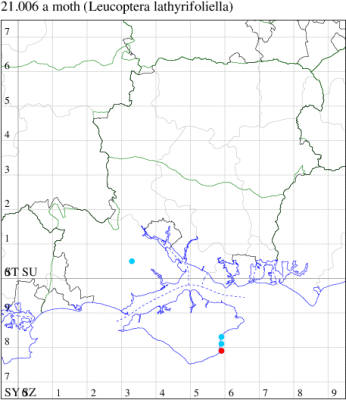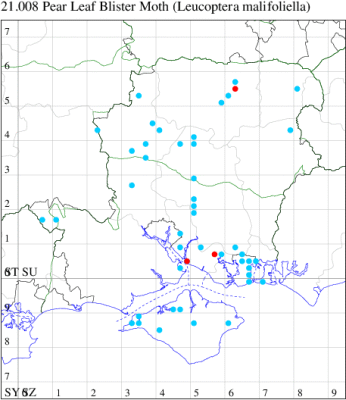2021 Annual Report for: Lyonetiidae / Cemiostominae
For species seen in 2021 that had less than or equal to 100 records, full details are included; for more common species, the earliest, latest and highest count by vice-county are shown. The narrative for each species is taken from the main Hantsmoths website, and it is possible that some information on abundance and occurrence can get out of date, as it is impossible to keep up with all changes; however it should give a good introduction to each species. The tables in each species account summarise the previous status, and that for the current year.
For the maps, all records prior to 2021 are shown by a blue dot (the larger the dot, the more recent), with the current year's records shown in red. As previous records are superimposed on any report for 2021, new sites have greater emphasis (i.e. will show as 'more red').
In the species accounts, an asterisk next to a location indicates a new 10km square record; earliest ever dates are highlighted in orange, and latest ever in red. Initials in the species accounts refer to the recorders listed here. Please get in touch if you identify any omissions or errors, in particular if you have records that have yet to be submitted. Details of how to submit records can be found here.
21.006 [B&F: 0258] Leucoptera lathyrifoliella (Stainton, [1865]) - pRDB2
Vulnerable (proposed as a future Red Data Book species) on sea cliffs and undercliffs on the coast of Devon from Torquay to Branscombe. On the Isle of Wight, still found at Luccombe Chine. In Hampshire formerly in Stubby Copse, near Brockenhurst, in the New Forest, but not reported since the 1940s. Wingspan 6-7 mm. Adults easily overlooked, and all records in our area relate to the larval mines on the leaves of Narrow-leaved Everlasting-pea, over-wintering as a pupa.
Records prior to 2021
| Vice County | #Records | #Individuals | First Record | Last Record |
|---|---|---|---|---|
| 10 | 23 | 401 | 1959 | 2020 |
| 11 | 2 | 5 | 1939 | 1940 |
2021 records
| Vice County | #Records | #Individuals | Max Quantity |
|---|---|---|---|
| 10 | 1 | 0 | 0 |

Records by year
Records by week (adult)
Records by week (larval)
Record Details
VC10: Bonchurch, mine, present, many mines on leaves of Lathyrus sylvestris, 10 Jul (PBar)
21.008 [B&F: 0260] Pear Leaf Blister Moth Leucoptera malifoliella (Costa, [1836]) - Common
Common, appearing in profusion in hot summers, in hedgerows, orchards and gardens throughout much of England, Wales and southern Scotland; otherwise, rather scarce. In Hampshire irregularly distributed in the south-east and north-west; on the Isle of Wight mainly restricted to the north coast. Wingspan 7-8 mm. Most records are of the larval mines, but occasionally recorded at light, the main confusion species being L. lotella, but forewing of L. malifoliella broader, with no purple-black apical spot, and third cilial bar directed more or less outwards (MBGBI Vol 2). Larva mines leaves of Hawthorn, Apple and Pear, causing sufficient damage to be a serious pest in some years, and over-wintering as a pupa.
Records prior to 2021
| Vice County | #Records | #Individuals | First Record | Last Record |
|---|---|---|---|---|
| 10 | 14 | 1 | 1900 | 2010 |
| 11 | 24 | 18 | 1981 | 2018 |
| 12 | 26 | 12 | 1973 | 2016 |
2021 records
| Vice County | #Records | #Individuals | Max Quantity |
|---|---|---|---|
| 11 | 2 | 2 | 1 |
| 12 | 1 | 0 | 0 |

Records by year
Records by week (adult)
Records by week (larval)
Record Details
VC11: Warsash, mine, one, on Malus, 30 Aug (DWal); Fareham, mine, one, on crab apple; there were numerous brown blotches, now too old to determine, which made searching more difficult, 03 Sep (RJD);
VC12: Sherborne St John, vacated mine, present, on Malus domestica, 29 Aug (MJW)
(Mine on Malus)(20210829_163011).jpg)